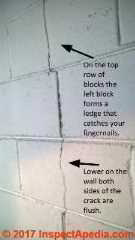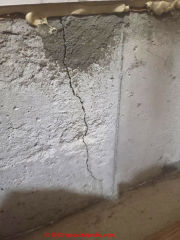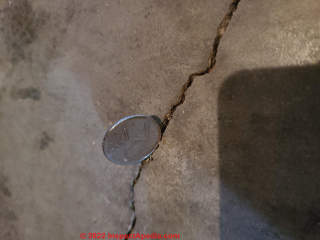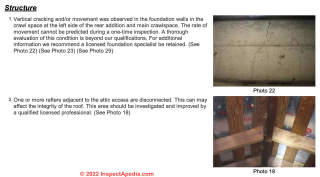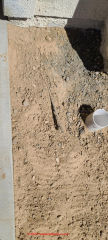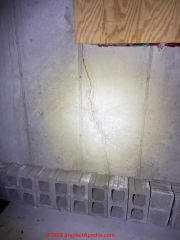 Vertical cracks in building foundations
Vertical cracks in building foundations
How to Diagnose & Evaluate Vertical Foundation Cracks
- POST a QUESTION or COMMENT about how we detect, diagnose & evaluate the impact of vertical cracks in building foundations or masonry walls
Vertical foundation crack diagnosis:
Foundation cracks and movement are discussed by type and location of foundation cracks, vertical foundation cracks, horizontal cracks, and diagonal foundation cracks, and shrinkage cracking.
This chapter of the "Foundation Crack Bible" discusses in detail the process of recognizing & evaluating vertical foundation cracks and foundation damage. Foundation cracks, which are signs of foundation damage, can mean very different things depending on the material from which a foundation is made, the location, size, and shape of the foundation crack, and other site observations.
InspectAPedia tolerates no conflicts of interest. We have no relationship with advertisers, products, or services discussed at this website.
Vertical Foundation Crack Causes, Patterns, Repairs
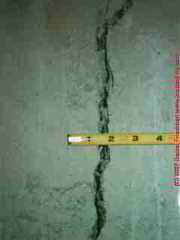
In the photos shown here, substantive cracks appeared and continued to increase in size in this poured concrete foundation used to support a modular home which had recently been completed.
The cracks and foundation movement were probably due to a combination of: poorly prepared foundation footings, blasting on an adjacent building lot to prepare that site for new construction, and possibly omission of steel reinforcement in the poured wall.
The cracks in this building foundation wall were visible shortly after construction as vertical hairline openings (less than 1/16" wide) in the right hand foundation wall, above grade and inside in the basement. Within a year the owner reported several times that the cracks were becoming noticeably wider.
A careful inspection of the building interior suggested that the front foundation wall and portions of the right foundation wall were settling. There were no corresponding cracks in the finished surfaces of the structure, probably because this was very stiffly-framed modular construction.
Notwithstanding the absence of damage upstairs, this was a problem that deserved further evaluation and repairs.
The builder may have repaired the foundation by supporting it from below using one of the methods described
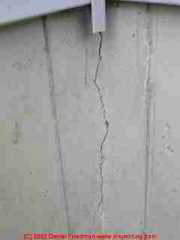
This settlement crack probably occurred during initial footing settlement. Notice that it is wider at the top than the bottom of the crack.
This suggests that the footing to the left or right of the crack has moved downwards, with further downwards movement as we move further from the crack itself.
If this is new construction and the crack does not change in width the site conditions may have stabilized.
How to Diagnose the significance of types of vertical cracks in foundations
- Vertical foundation cracks in masonry between two structures - differential settlement or thermal movement, often seen where an add-on garage is built on more shallow footings on backfill next to a full foundation.
- Vertical, nearly straight or wandering cracks in poured concrete, generally even width, intermittent, or more often straight - shrinkage / thermal - low risk
- Vertical cracks, straight generally even width, in a masonry block wall, in mortar joints but possibly right through concrete block - shrinkage / thermal - low to modest risk
- Vertical foundation cracks that are straight or stepped in brick, especially near ends of wall - expansion / thermal, potentially dangerous if wall bond courses are broken, collapse risk.
- Vertical cracks in a foundation wall, wider at bottom than top - usually due to settlement under building, occasionally due to frost heave at a point.
These cracks may be less serious than horizontal when found in a masonry block wall. These cracks could be quite serious when found in a brick wall, especially if bond courses are broken and there is risk of collapse. - Vertical cracks in a foundation wall, uniform in width, one side of crack/wall higher than the other: differential settlement in footings, possibly a serious defect; this crack may have the same cause as the tapered crack above but suggests that the footing has both broken and settled straight down at one side of the crack
The vertical crack in a masonry block wall shown in our photograph is discussed
at VERTICAL CRACKS in BLOCK WALLS
Multiple vertical cracks in building foundations
Vertical foundation cracks often appear in multiples multiple cracks in one or more area.
While a vertical foundation crack could be serious depending on its cause and on the type of foundation in which it appears (stone, brick, masonry block, concrete), these are often the least threat to the building.
If there is significant vertical dislocation or signs of ongoing movement, further investigation is more urgent. If the cause is shrinkage (concrete, masonry block) it is probably less of a concern than if due to settlement.
A vertical crack due to earth loading or frost would be unusual except when the whole wall leans in and cracks occur (usually) near an inside foundation corner such as shown in our photo below
Reader Comments, Questions & Answers About The Article Above
Below you will find questions and answers previously posted on this page at its page bottom reader comment box.
Reader Q&A - also see RECOMMENDED ARTICLES & FAQs
On 2023-08-16 by InspectApedia Publisher
@Violet,
The home has been there for more than eight decades without falling-down. In my OPINION no one should "walk away" from a home and neighborhood that they like because they see a crack. Rather it needs to be understood and from that we need to know what to expect and what action(s) are needed.
The article above is an important and easy read that I recommend for you addresses vertical foundation cracks like the one in your photo:
PLEASE POST your further photos, questions, inspector's comments, etc. here as it's the best way to get help on the topic of vertical foundation cracks.
You'll see that from your photo we can say that the crack is "significant" (more than hairline in width), that if it is the only crack and movement, and considering the building age,
- it may not represent a "dangerous" condition at all
- really you need to look at the entire building and foundation, in this case from inside the crawl space as well - no one with any experience and sense would diagnose the building from a single photo
- the key steps are to evaluate the effect of the crack on the structure, its age and history, its cause, and thus its future behavior.
A clue is that downspout extension. If the home is in a wet/freezing climate someone may think that spilling water around the foundation was a contributor to the foundation movement.
On 2023-08-16 by Violet
How dangerous is this? They've been filled in but last prospective buyer walked away. I really like the home. It's on a crawlspace, built in 1939, 809 sq ft. Thanks so much!
This reader's Q&A were originally posted at HOW TO CONTACT InspectApedia.com
On 2022-02-14 by Inspectapedia Com Moderator - do I need an onsite inspection of foundation cracks
@Anonymous,
Those look like foundation or footing settlement cracks - worth having an onsite inspection to evaluate impact on structure and probable cause.
On 2022-02-14 by Moe
Hi,
We recently bought a 2009 end-unit townhouse. Few vertical cracks just appeared on my garage inside wall (shared wall with my neighbor's garage). One of them, crack can fit a dime in the top of the crack. The crack's top is wider than it's bottom. There are 2 other hairline cracks on the same wall (3 in total) and 2 hairline cracks on the parallel wall of the garage .
In addition, my basement concrete had also shown multi direction cracks where I can fit a dime as well . Please advise. thank you
On 2021-09-17 by inspectapedia.com.moderator - roof rafter separation needs further investigation and repair
@Ash,
This is a very thin hairline crack, discontinuous, with no sign of lateral dislocation; I'm not sure from your photo if the crack extends further down the foundation wall or not. It's not enough movement to have measurably disturbed building framing or other components.
That type wandering, dis-continuous hairline crack in the foundation most-likely occurred shortly after original construction, perhaps from the combined forces of footing settlement and concrete shrinkage that occurred then. Notice that the crack is both wandering and discontinuous near the top, close to a form mark? If concrete "breaks" due to settlement later after it has hardened, it will never produce a dis-continuous crack.
It would be helpful to know the age of the home; if this home is several years old or older, and there's no sign of ongoing movement elsewhere in the foundation it's certainly not an urgent concern.
Your inspector, in a normal "CYA" report, recommends a licensed design specialist such as a structural or civil engineer who is familiar with residential concrete foundations, their installation, inspection, failure and repair; and of course you're welcome to do that.
OPINON: While none of us is a structural or civil engineer, we are familiar with this type of foundation cracking; if you don't see new signs of movement no repair is needed.
Watch for water entry at such cracks - a separate issue.
The roof rafter separation from the ridge board needs further investigation and repair;
Normal roof forces press "in" towards the ridge, not away from it;
If there are no collar ties and if there are missing ceiling joists, I'd be looking for bending bulging walls = leaning out at wall top; If there's no such evidence then simple repair such as adding some steel connectors or collar ties may be sufficient. Any experienced roof framer can attend this, even a skilled handyman familiar with roof framing.
Despite a modern concrete foundation there are signs that the home itself may be older: do tell.
That's a bit of an odd roof structure; I think I see exposed nails and more than one generation of framing materials. It looks almost as if the roof has been re-framed and then decked with foil faced insulation, presumably over which someone added plywood roof decking. If so this may be an older home with a major re-roof job. Spaced board sheathing was usually used under wood shingles or shakes.
Where is this home and how old is it?
On 2021-09-17 by Ash
Thanks so much for your website!! I was wondering what you think about the two issues in the attached photo - are the foundation cracks and the roof dislocation connected? There is also "larger than normal cracking and/or movement in the concrete floor of the garage".
This is in the home inspection report of a home that I really like, but I'm worried that these point to settlement which seems quite serious?
On 2021-09-14 by inspectapedia.com.moderator
@Jae,
I can not see any cracks in your stucco exterior wall, nor more than a few inches of the wall;
I do see what looks like a multi-strand wire, possibly intended to be an electrical ground connection, sticking up out of the dirt.
Check inside: if you find this wire leading to the electrical panel it's probably intended to connect to a grounding electrode that has not been installed.
On 2021-09-14 by Jae
I am noticing vertical hairline cracks appearing on exterior stucco wall in new construction home. I also see steel wire coming out exposed in the picture. What should the builder do to make sure there isn't material foundation defect?
On 2020-11-28 by danjoefriedman (mod) - additional info needed and tips offered for good inspection practices
I apologize to you for not being able to be more definitive. The problem is you really need, in order to make sense of a foundation crack more data than just a photo of crack. I suggested an article that gives some criteria for assessing the probability that the damage is significant. Were you able to take a look at that?
On 2020-11-28 by Jeremy
Thank you very much for the prompt response. Unfortunately, researching foundation cracks on the internet is similar to researching a headache on the internet--you either simply have a headache, or you have cancer. I have found so much conflicting information about these cracks on the internet that I briefly convinced myself that this crack means half of the house is going to collapse.
But I do appreciate the insight, and I agree that the one photo alone does not provide enough information to give good guidance. However, this is a foreclosure home and unfortunately, no other information is available from the sellers nor their agents.
Either way, I do thank you again for the prompt response and I will be sure to follow up here if we buy the home and get it checked out by a foundation expert, just in case anyone else has a similar issue in the future.
Oops! I forgot one important detail: we did notice some diagonal cracking in drywall in some of the 2nd floor bedrooms, from the corner of door frames out maybe 5-10 inches. Nothing severe, and just hairline cracks, but I did notice them. However, I thought that was just indicative of a nearly 20-year-old home as I have seen that in many homes of this area (Northeast PA) that we've been looking at.
And, those drywall cracks were on the same side of the house as this foundation crack, but we did see some more drywall cracks like this on the opposite end of the home.
On 2020-11-27 by danjoefriedman (mod)
1. Move those concrete blocks to make sure that they're not hiding something interesting
2. Inspect the rest of the foundation for cracks, movement, leaning, bulging, etc.
Those are simply good inspection practices.
3. Discuss this crack with your home inspector who will have examined the whole structure and can often see the presence or discuss the absence of related observations that raise or lower the possible concern
4. Most likely this is a foundation or footing settlement crack like those discussed on this page. What else has moved or been disturbed in the structure or framing? (Probably nothing). Are there other signs of movement in the building? How old is this crack? Is it ongoing movement?
Armed with those simple basics then let's take a look at FOUNDATION DAMAGE SEVERITY for some general guidance;
Nobody can make a completely confident diagnosis of the condition of a building with no more information than what we have so far but I suspect this crack alone, with no other movement signs, is not a show-stopper, and occurs at a rather common location (corner of a window).
On 2020-11-27 by Jeremy
Hi, we are interested in a home that has a vertical/diagonal crack from the corner of a basement window, on a poured foundation. A photo is attached. It appears the crack is larger at the top than the bottom, which I know is typically more serious than just a small hairline crack. Please let me know what you think. Thanks.
On 2020-08-06 by Ulanda
Yes, the previous owner inserted the foam in the crack.
On 2020-07-30 - by (mod) -
Ulanda
Is that orange stuff a foam sealant?
Foam may stop or slow water or air leaks but it's not a structural repair;
Your contractor will want to know the cause of wall movement, the extent of wall movement, and whether or not movement is ongoing and so requires repair or reinforcement.
On 2020-07-29 by Ulanda
Also, this crack is along side of the house. It is not near a garage.
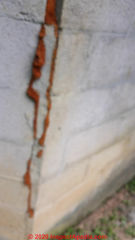
The crack is located at the joint of two sides of the foundation. I see that I can only upload one picture. [at a time but as many as I want, one per comment]
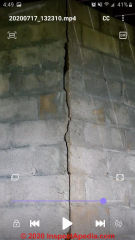
On 2020-07-20 by (mod)
Ulanda
I can't see enough from the photo nor do I have enough other information to be confident in a diagnosis or opinion about the foundation crack in your photo.
Vertical cracks don't usually Trenton collapse in a concrete block foundation wall.
But I can't tell for sure in your photo if I'm looking at the center of a wall or a corner where in a broken or bulging concrete block foundation wall is leaning.
The second would be a more serious and more immediate concern.
Please take a look at the article above where we discussed some approaches to evaluating vertical cracks in foundations. You'll see that we need to understand the cause, the extent and location of all of the cracks, and the extent of damage to the structure, before we can have an opinion about what remediation or repair steps are needed.
On 2020-07-20 by Ulanda
Vertical Crack at the corner of a foundation. This is a home for sale that we are thinking about buying as a fixer upper. What is your general assessment just from the picture. It looks like foam was inserted at some point.
On 2020-07-03 - by (mod) -
garage floor shrinkage gap around perimeter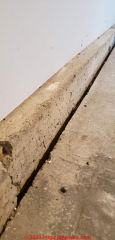 Vic
Vic
It looks to me as if you're showing a uniform shrinkage gap around the perimeter of a garage slab - is that right?
If so, it's not a defect as long as the crack only shows shrinkage - that is, as long as the slab has not also settled downwards or tipped.
If, however this is a new gap in an old house, I suspect that there is new settlement under the slab, perhaps due to roof runoff spilling by the building or in-slope grade sending water towards the building.
In that case further investigation is needed before we can have an opinion about what repair is needed.
If I'm supposed to be commenting on the single vertical crack in the wall base or foundation, and if that's new, the same causes need to be investigated.
Whether or not there is a foundation repair needed depends on how much movement has occurred, whether or not the structure is threatened - which I can't see in this photo.
On 2020-07-03 by Vic
Have this garage running through base of my garage wall on one side due to potential settling, the house was built in the 60s.
How serious is this and what would it take to remediate?
Thanks
On 2019-10-11 - by (mod) - repair vertical crack in new concrete foundation now rather than later
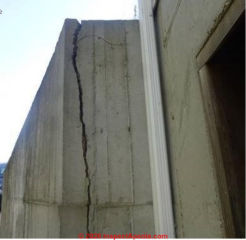 It looks like a serious problem of a rotating Foundation footing. I would not proceed with construction before the cause is diagnosed and fixed. Otherwise ongoing movement and damage it causes maybe more-costly to repair later.
It looks like a serious problem of a rotating Foundation footing. I would not proceed with construction before the cause is diagnosed and fixed. Otherwise ongoing movement and damage it causes maybe more-costly to repair later.
On 2019-10-04 by Josh
Looking to buy a house, the driveway is down a decently steep grade.
The concrete is attached to the foundation but flares out to act as a wall blocking the ground above the huge grade.
In your opinion, is it just the wall portion or the foundation that has moved.
The crack is vertical and pretty wide.
This Q&A were posted originally at VERTICAL CRACKS in BLOCK WALLS
On 2018-08-28 7 by (mod) - diagnostic notes on foundation cracks
Michael
No one with any experience and sense would pretend that she could diagnose building structural damage nor assess its extent from a few photos; in my experience 100% of the time that I've gone to a building site under question there was important additional information that wasn't in the initial presentation.
With that caveat given, what I can see in your photos includes:
- two photos of foundation walls from different building areas show vertical cracks through a masonry veneer or foundation - of unknown remaining materials.
- one of those photos shows a crack that's about 1/4" wide or wider, and shows vertical dislocation as well - settlement
- another exterior photo shows drainage by the foundation - you don't give country, city, climate, nor other information, but even in a non-freeze climate spillage by a foundation wall invites settlement and damage.
- an interior photo shows down wards movement of the right hand wall and tearing of the paper cover on what's probably drywall in the corner, consistent with some structural movement
There are too many open questions to reach a conclusion other than that there is the possibility of the need for costly repairs to the building (of unknown age, material, constructions, location, soil conditions, etc).
An on-site expert is needed to find the cause, extent of movement, history of movement, its impact on the structure, and to help determine what additional work is appropriate.
If you must buy such a property without performing due diligence inspections you must allow for the possibility of costly follow-up investigation and repair work. No I cannot give "a number" as we know almost nothing.
On 2018-08-28 by Michael Giuffre
Third picture - interior wall joint in between exterior cracks
IMAGE LOST by older version of Comments code - now fixed. Please re-post the image if you can. Sorry. Mod.
Second picture
IMAGE LOST by older version of Comments code - now fixed. Please re-post the image if you can. Sorry. Mod.
I am trying to identify the severity of these slab foundation cracks found in a property I am about to purchase.
I’ve attached both exterior and interior pictures that indicate possible settlement but I’m not able to get a foundation expert to the property before due diligence ends. All help is greatly appreciated!
IMAGE LOST by older version of Comments code - now fixed. Please re-post the image if you can. Sorry. Mod.
On 2018-07-23 by (mod) -
Don't know, for sure, Hara.
Is this really a solid, poured concrete wall and not a veneer over something else? In the center of your photo where more concrete coating is lost I see a very straight edge that looks - from here, like plywood.
On 2018-07-23 by Hara Totapally
The crack in the attached image is in the concrete wall of a three years old building. Is this normal or points to a structural DEFECT?
IMAGE LOST by older version of Comments code - now fixed. Please re-post the image if you can. Sorry. Mod.
On 2018-07-03 by (mod) -
Your photo does not show a slab crack.
Slab is a term used to refer to a flat concrete floor that would be typically found in a basement or as the main floor if a house is built as slab on grade with no basement or crawlspace.
What I do senior photo is a vertical crack in a masonry foundation wall.
I suspect this is a settlement crack but your home inspector, who has seen the entire site and the interior and exterior of the building, should tell you what's going on and whether she thinks this is an ongoing problem, initial settlement, something that needs further attention, or something that does not.
If the home inspector simply pointed out something to you as existing but failed to help you understand the significance of the observation and whether or not it is a safety question or a significant expense question then that inspector has not done their job. A home inspection is not merely an inventory.
It's not uncommon for some settlement to occur in new construction, particularly if the footings that support the foundation were not properly made or were placed on soft soil or poorly compacted fill.
The substantive the questions that I'm sure your home inspector can and should address are at least these:
Has the foundation cracking caused damage to the structure such as pulling apart or separation of structural connections. I would not expect that to be the case from a vertical settlement crack.
Is the movement ongoing or does it appear to be stabilized - unfortunately the newer the construction the more difficult it may be to determine that.
And the home inspector will give you an evaluation of whether or not she thinks further inspection or analysis are truly justified ( as opposed to simply saying at every event "hire an expert" which of course is spending your money to reduce the inspectors risk)
or whether she thinks you should watch for evidence of continued movement.
She may also issue a warning of potential significant costs in the uncommon case that repairs to the supporting foundation or footings are needed.
Are there any repairs that are needed such as sealing to prevent water entry?
On 2018-07-03 by Willy
one more pic from my posting. the house is 3 years old.
IMAGE LOST by older version of Comments code - now fixed. Please re-post the image if you can. Sorry. Mod.
On 2018-07-03 by Willy
Hello, I am in the process of buying a house -first time- and my inspection report came back with a few slab cracks. Can you please let me know if these crack should be a concern. I really appreciate your feedback.
IMAGE LOST by older version of Comments code - now fixed. Please re-post the image if you can. Sorry. Mod.
On 2018-05-07 by (mod) -
Arnold
Thanks for a good question. Use the Add Image button to add photos to your comments, one at a time.
A foundation engineer will generally say that ANY crack is a "failure" in the foundation.
However depending on size, shape, location, pattern, extent of foundation movement, and importantly - the cause, some cracks often can be ignored.
In the case of your example it's not the crack width (1/16") alone that would allow someone to answer your question with confidence.
What's the age of the cracks? What's the cause? Those tell us what we can expect in the future.
On 2018-05-07 by Arnold
Are vertical and diagonal cracks in foundation walls (all less than 1/16") something that needs to concerned about from a structural perspective? I have pictures I can send to you in word or pdf format.
...
Continue reading at VERTICAL FOUNDATION MOVEMENT REPAIRS or select a topic from the closely-related articles below, or see the complete ARTICLE INDEX.
Or see these
Recommended Articles
- BLOCK FOUNDATION & WALL DEFECTS - home
- CONCRETE or MASONRY DAMAGE TESTS
- FOUNDATION DAMAGE & REPAIR GUIDE - home
- FOUNDATION DAMAGE SEVERITY
- FOUNDATION FAILURES by MOVEMENT TYPE - home
- FOUNDATION FAILURES by TYPE & MATERIAL - home
- VERTICAL MOVEMENT IN FOUNDATIONS
Suggested citation for this web page
VERTICAL FOUNDATION CRACKS at InspectApedia.com - online encyclopedia of building & environmental inspection, testing, diagnosis, repair, & problem prevention advice.
Or see this
INDEX to RELATED ARTICLES: ARTICLE INDEX to BUILDING STRUCTURES
Or use the SEARCH BOX found below to Ask a Question or Search InspectApedia
Ask a Question or Search InspectApedia
Try the search box just below, or if you prefer, post a question or comment in the Comments box below and we will respond promptly.
Search the InspectApedia website
Note: appearance of your Comment below may be delayed: if your comment contains an image, photograph, web link, or text that looks to the software as if it might be a web link, your posting will appear after it has been approved by a moderator. Apologies for the delay.
Only one image can be added per comment but you can post as many comments, and therefore images, as you like.
You will not receive a notification when a response to your question has been posted.
Please bookmark this page to make it easy for you to check back for our response.
Our Comment Box is provided by Countable Web Productions countable.ca
Citations & References
In addition to any citations in the article above, a full list is available on request.
- Avongard FOUNDATION CRACK PROGRESS CHART [PDF] - structural crack monitoring
- Building Pathology, Deterioration, Diagnostics, and Intervention, Samuel Y. Harris, P.E., AIA, Esq., ISBN 0-471-33172-4, John Wiley & Sons, 2001 [General building science-DF] ISBN-10: 0471331724 ISBN-13: 978-0471331728
- Building Pathology: Principles and Practice, David Watt, Wiley-Blackwell; 2 edition (March 7, 2008) ISBN-10: 1405161035 ISBN-13: 978-1405161039
- Diagnosing & Repairing House Structure Problems, Edgar O. Seaquist, McGraw Hill, 1980 ISBN 0-07-056013-7 (obsolete, incomplete, missing most diagnosis steps, but very good reading; out of print but used copies are available at Amazon.com, and reprints are available from some inspection tool suppliers). Ed Seaquist was among the first speakers invited to a series of educational conferences organized by D Friedman for ASHI, the American Society of Home Inspectors, where the topic of inspecting the in-service condition of building structures was first addressed.
- Design of Wood Structures - ASD, Donald E. Breyer, Kenneth Fridley, Kelly Cobeen, David Pollock, McGraw Hill, 2003, ISBN-10: 0071379320, ISBN-13: 978-0071379328
This book is an update of a long-established text dating from at least 1988 (DJF); Quoting:
This book is gives a good grasp of seismic design for wood structures. Many of the examples especially near the end are good practice for the California PE Special Seismic Exam design questions. It gives a good grasp of how seismic forces move through a building and how to calculate those forces at various locations. THE CLASSIC TEXT ON WOOD DESIGN UPDATED TO INCLUDE THE LATEST CODES AND DATA. Reflects the most recent provisions of the 2003 International Building Code and 2001 National Design Specification for Wood Construction. Continuing the sterling standard set by earlier editions, this indispensable reference clearly explains the best wood design techniques for the safe handling of gravity and lateral loads. Carefully revised and updated to include the new 2003 International Building Code, ASCE 7-02 Minimum Design Loads for Buildings and Other Structures, the 2001 National Design Specification for Wood Construction, and the most recent Allowable Stress Design. - Building Failures, Diagnosis & Avoidance, 2d Ed., W.H. Ransom, E.& F. Spon, New York, 1987 ISBN 0-419-14270-3
- Domestic Building Surveys, Andrew R. Williams, Kindle book, Amazon.com
- Defects and Deterioration in Buildings: A Practical Guide to the Science and Technology of Material Failure, Barry Richardson, Spon Press; 2d Ed (2001), ISBN-10: 041925210X, ISBN-13: 978-0419252108. >
- Guide to Domestic Building Surveys, Jack Bower, Butterworth Architecture, London, 1988, ISBN 0-408-50000 X
- "Avoiding Foundation Failures," Robert Marshall, Journal of Light Construction, July, 1996 (Highly recommend this article-DF)
- "A Foundation for Unstable Soils," Harris Hyman, P.E., Journal of Light Construction, May 1995
- "Backfilling Basics," Buck Bartley, Journal of Light Construction, October 1994
- "Inspecting Block Foundations," Donald V. Cohen, P.E., ASHI Reporter, December 1998. This article in turn cites the Fine Homebuilding article noted below.
- "When Block Foundations go Bad," Fine Homebuilding, June/July 1998
- Quality Standards for the Professional Remodeling Industry, National Association of Home Builders Remodelers Council, NAHB Research Foundation, 1987.
- Quality Standards for the Professional Remodeler, N.U. Ahmed, # Home Builder Pr (February 1991), ISBN-10: 0867183594, ISBN-13: 978-0867183597
- Slab on Grade Foundation Moisture and Air Leakage, U.S. Department of Energy
Technical Reviewers
- Sal Alfano - Editor, Journal of Light Construction*
- Thanks to Alan Carson, Carson Dunlop, Associates, Toronto, for technical critique and some of the foundation inspection photographs cited in these articles
- Terry Carson - ASHI
- Mark Cramer - ASHI
- JD Grewell, ASHI
- Duncan Hannay - ASHI, P.E. *
- Bob Klewitz, M.S.C.E., P.E. - ASHI
- Ken Kruger, P.E., AIA - ASHI
- Bob Peterson, Magnum Piering - 800-771-7437 - FL*
- Arlene Puentes, ASHI, October Home Inspections - (845) 216-7833 - Kingston NY
- Greg Robi, Magnum Piering - 800-822-7437 - National*
- Dave Rathbun, P.E. - Geotech Engineering - 904-622-2424 FL*
- Ed Seaquist, P.E., SIE Assoc. - 301-269-1450 - National
- Dave Wickersheimer, P.E. R.A. - IL, professor, school of structures division, UIUC - University of Illinois at Urbana-Champaign School of Architecture. Professor Wickersheimer specializes in structural failure investigation and repair for wood and masonry construction. * Mr. Wickersheimer's engineering consulting service can be contacted at HDC Wickersheimer Engineering Services. (3/2010)
- *These reviewers have not returned comment 6/95
Technical Edits, Changes, Amendments to This Document
- 9/23/2006 editing to clarify text and add content; Technical review (partial) by Arlene Puentes.
- 4/17/2006 editing to clarify text in several sections.
- 2/6/99 editing updates, soliciting additional reviews
- 2/3/99 Converted working text file to MSWord97 .doc and .htm files for easier review on Internet
- 6/26/95 text updates per comments from Al Carson, Terry Carson, Mark Cramer 6/16/95 text updates for Calgary July 1995
- cc's sent to reviewers
- 3/28/95 uploaded to ASHI's Internet site - asfoun01.txt
- 11/19/93 Ed Seaquist - telecon 11/19/93, likes, will write up one of our sections for my/our target of series of journal articles or a book.
- © Dan Friedman 2013, 1999, original 1992 All Rights Reserved -- foundation.htm
- Masonry structures: The Masonry House, Home Inspection of a Masonry Building & Systems, Stephen Showalter (director, actor), DVD, Quoting:
Movie Guide Experienced home inspectors and new home inspectors alike are sure to learn invaluable tips in this release designed to take viewers step-by-step through the home inspection process. In addition to being the former president of the National Association of Home Inspectors (NAHI), a longstanding member of the NAHI, the American Society of Home Inspectors (ASHI), and the Environmental Standard Organization (IESO), host Stephen Showalter has performed over 8000 building inspections - including environmental assessments. Now, the founder of a national home inspection school and inspection training curriculum shares his extensive experience in the inspection industry with everyday viewers looking to learn more about the process of evaluating homes. Topics covered in this release include: evaluation of masonry walls; detection of spalling from rebar failure; inspection of air conditioning systems; grounds and landscaping; electric systems and panel; plumbing supply and distribution; plumbing fixtures; electric furnaces; appliances; evaluation of electric water heaters; and safety techniques. Jason Buchanan --Jason Buchanan, All Movie Review - Best Practices Guide to Residential Construction, by Steven Bliss. John Wiley & Sons, 2006. ISBN-10: 0471648361, ISBN-13: 978-0471648369, Hardcover: 320 pages, available from Amazon.com and also Wiley.com. See our book review of this publication.
- The Journal of Light Construction has generously given reprint permission to InspectAPedia.com for certain articles found at this website. All rights and contents to those materials are ©Journal of Light Construction and may not be reproduced in any form.
- Straw Bale Home Design, U.S. Department of Energy provides information on strawbale home construction - original source at http://www.energysavers.gov/your_home/designing_remodeling/index.cfm/mytopic=10350
- More Straw Bale Building: A Complete Guide to Designing and Building with Straw (Mother Earth News Wiser Living Series), Chris Magwood, Peter Mack, New Society Publishers (February 1, 2005), ISBN-10: 0865715181 ISBN-13: 978-0865715189 - Quoting:
Straw bale houses are easy to build, affordable, super energy efficient, environmentally friendly, attractive, and can be designed to match the builder’s personal space needs, esthetics and budget. Despite mushrooming interest in the technique, however, most straw bale books focus on “selling” the dream of straw bale building, but don’t adequately address the most critical issues faced by bale house builders. Moreover, since many developments in this field are recent, few books are completely up to date with the latest techniques.
More Straw Bale Building is designed to fill this gap. A completely rewritten edition of the 20,000-copy best--selling original, it leads the potential builder through the entire process of building a bale structure, tackling all the practical issues: finding and choosing bales; developing sound building plans; roofing; electrical, plumbing, and heating systems; building code compliance; and special concerns for builders in northern climates. - In addition to citations & references found in this article, see the research citations given at the end of the related articles found at our suggested
CONTINUE READING or RECOMMENDED ARTICLES.
- Carson, Dunlop & Associates Ltd., 120 Carlton Street Suite 407, Toronto ON M5A 4K2. Tel: (416) 964-9415 1-800-268-7070 Email: info@carsondunlop.com. Alan Carson is a past president of ASHI, the American Society of Home Inspectors.
Thanks to Alan Carson and Bob Dunlop, for permission for InspectAPedia to use text excerpts from The HOME REFERENCE BOOK - the Encyclopedia of Homes and to use illustrations from The ILLUSTRATED HOME .
Carson Dunlop Associates provides extensive home inspection education and report writing material. In gratitude we provide links to tsome Carson Dunlop Associates products and services.


